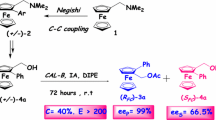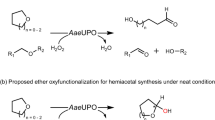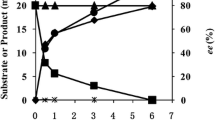Abstract
tert-Butyl (3R,5S)-6-chloro-3,5-dihydroxyhexanoate [(3R,5S)-CDHH] is the key chiral intermediate to synthesize the side chain of the lipid-lowering drug rosuvastatin. Carbonyl reductases showed excellent activity for the biosynthesis of (3R,5S)-CDHH. The requirement of cofactor NADH/NADPH leads to high cost for the industrial application of carbonyl reductases. In this study, a self-sufficient biocatalyst based on carbonyl reductase and NADP+ co-immobilization strategy was developed on an amino resin carrier LX-1000HAA (SCR-NADP+@LX-1000HAA). The self-sufficient biocatalyst achieved in situ cofactor regeneration and showed the activity recovery of 77.93% and the specific activity of 70.45 U/g. Asymmetric synthesis of (3R,5S)-CDHH using SCR-NADP+@LX-1000HAA showed high enantioselectivity (> 99% e.e.) and yield (98.54%). Batch reactions were performed for ten cycles without extra addition of NADP+, and the total yield of (3R,5S)-CDHH achieved at 10.56 g/g biocatalyst. The present work demonstrated the potential of the self-sufficient biocatalyst for the asymmetric biosynthesis of rosuvastatin intermediate.
Graphic abstract










Similar content being viewed by others
References
Liu J, Zhu LP, Yang XL, Huang HL, Ye DQ (2013) HMG-CoA reductase inhibitors (statins) and bone mineral density: a meta-analysis. Bone 54(1):151–156
Casar Z (2010) Historic overview and recent advances in the synthesis of super-statins. Curr Org Chem 14(8):816–845
Blaha MJ, Martin SS (2013) How do statins work? Changing paradigms with implications for statin allocation. J Am Coll Cardiol 62(25):2392–2394
Hirsch M, O'Donnell J, Olsson A (2005) Rosuvastatin is cost-effective compared with atorvastatin in reaching cholesterol goals. Int J Cardiol 104(3):251–256
Aggarwal RK, Showkathali R (2013) Rosuvastatin calcium in acute coronary syndromes. Expert Opin Pharmacother 14(9):1215–1227
Sirtori CR (2014) The pharmacology of statins. Pharmacol Res 88(9):3–11
Wu Y, Xiong FJ, Chen FE (2015) Stereoselective synthesis of 3-hydroxy-3-methylglutaryl–coenzyme A reductase inhibitors. Tetrahedron 71(45):8487–8510
Mclean CC, Teft WA, Morse BL, Gryn SE, Hegele RA, Kim RB (2018) Food effect on rosuvastatin disposition and low-density lipoprotein cholesterol. Clin Pharmacol Ther 104(3):525–533
Tartaggia S, Fogal S, Motterle R, Ferrari C, Pontini M, Aureli R, De Lucchi O (2016) Chemoenzymatic synthesis of δ-keto β-hydroxy esters as useful intermediates for preparing statins. Eur J Org Chem 19:3162–3165
Tartaggia S, Ferrari C, Pontini M, De Lucchi O (2015) A practical synthesis of rosuvastatin and other statin intermediates. Eur J Org Chem 46(19):4102–4107
Patel RN (2018) Biocatalysis for synthesis of pharmaceuticals. Biorg Med Chem 26(7):1252–1274
Liu ZQ, Wu L, Zhang XJ, Xue YP, Zheng YG (2017) Directed evolution of carbonyl reductase from Rhodosporidium toruloides and its application in stereoselective synthesis of tert-butyl (3R,5S)-6-chloro-3,5-dihydroxyhexanoate. J Agric Food Chem 65(18):3721–3729
Amidjojo M, Franco-Lara E, Nowak A, Link H, Weuster-Botz D (2005) Asymmetric synthesis of tert-butyl (3R,5S)-6-chloro-dihydroxyhexanoate with Lactobacillus kefir. Appl Microbiol Biotechnol 69(1):9–15
He XJ, Chen SY, Wu JP, Yang LR, Xu G (2015) Highly efficient enzymatic synthesis of tert-butyl (S)-6-chloro-5-hydroxy-3-oxohexanoate with a mutant alcohol dehydrogenase of Lactobacillus kefir. Appl Microbiol Biotechnol 99(21):8963–8975
Liu ZQ, Wu L, Zheng L, Wang WZ, Zhang XJ, Jin LQ, Zheng YG (2017) Biosynthesis of tert-butyl (3R,5S)-6-chloro-3,5-dihydroxyhexanoate by carbonyl reductase from Rhodosporidium toruloides in mono and biphasic media. Bioresour Technol 249:161–167
Xu T, Wang C, Zhu S, Zheng G (2017) Enzymatic preparation of optically pure t-butyl 6-chloro-(3R,5S)-dihydroxyhexanoate by a novel alcohol dehydrogenase discovered from Klebsiella oxytoca. Process Biochem 57:72–79
Liu ZQ, Hu ZL, Zhang XJ, Tang XL, Cheng F, Xue YP, Wang YJ, Wu L, Yao DK, Zhou YT (2017) Large-scale synthesis of tert-butyl (3R,5S)-6-chloro-3,5-dihydroxyhexanoate by a stereoselective carbonyl reductase with high substrate concentration and product yield. Biotechnol Prog 33(3):612–620
Eastgate MD, Schmidt MA, Fandrick KR (2017) On the design of complex drug candidate syntheses in the pharmaceutical industry. Nat Rev Chem 1(2):0016
Wolberg M, Villela M, Bode S, Geilenkirchen P, Feldmann R, Liese A, Hummel W, Muller M (2008) Chemoenzymatic synthesis of the chiral side-chain of statins: application of an alcohol dehydrogenase catalysed ketone reduction on a large scale. Bioprocess Biosyst Eng 31(3):183–191
Chen LF, Fan HY, Zhang YP, Wei W, Lin JP, Wei DZ, Wang HL (2017) Enhancement of ethyl (S)-4-chloro-3-hydroxybutanoate production at high substrate concentration by in situ resin adsorption. J Biotechnol 251:68–75
Honda K, Inoue M, Ono T, Okano K, Dekishima Y, Kawabata H (2017) Improvement of operational stability of Ogataea minuta carbonyl reductase for chiral alcohol production. J Biosci Bioeng 123(6):673–678
Tang YP, Zhang GM, Wang Z, Liu D, Zhang LL, Zhou YF, Huang J, Yu FM, Yang ZS, Ding GF (2018) Efficient synthesis of a (S)-fluoxetine intermediate using carbonyl reductase coupled with glucose dehydrogenase. Bioresour Technol 250:457–463
Rocha-Martin J, Vega D, Bolivar JM, Hidalgo A, Berenguer J, Guisan JM, Lopez-Gallego F (2012) Characterization and further stabilization of a new anti-prelog specific alcohol dehydrogenase from Thermus thermophilus HB27 for asymmetric reduction of carbonyl compounds. Bioresour Technol 103(1):343–350
Tang JW, Wei TY, Ni GW, Guo X, Wu YJ, Zhang FL, Chen SX (2018) Development of an efficient and cost-effective enzymatic process for production of (R)-3,5-bis(trifluoromethyl)phenyl ethanol using carbonyl reductase derived from Leifsonia sp. S749. Appl Biochem Biotechnol https://doi.org/10.1007/s12010-018-2904-2
Li KP, Zhang RZ, Xu Y, Wu ZM, Li J, Zhou XT, Jiang JW, Liu HY, Xiao R (2017) Sortase A-mediated crosslinked short-chain dehydrogenases/reductases as novel biocatalysts with improved thermostability and catalytic efficiency. Sci Rep 7(1):3081–3091
Zheng YG, Yin HH, Yu DF, Chen X, Tang XL, Zhang XJ, Xue YP, Wang YJ, Liu ZQ (2017) Recent advances in biotechnological applications of alcohol dehydrogenases. Appl Microbiol Biotechnol 101(3):987–1001
Wang XX, Lin CP, Zhang XJ, Liu ZQ, Zheng YG (2018) Improvement of a newly cloned carbonyl reductase and its application to biosynthesize chiral intermediate of duloxetine. Process Biochem 70:124–128
Li M, Zhang ZJ, Kong XD, Yu HL, Zhou JH, Xu JH (2017) Engineering streptomyces coelicolor carbonyl reductase for efficient atorvastatin precursor synthesis. Appl Environ Microbiol 83(12):673–678
Kizaki N, Yamada Y, Yasohara Y, Hasegawa J (2003) Carbonyl reductase, gene thereof and method of using the same. US Patent 6645746 B1
Begemann J, Ohs RBH, Ogolong AB, Eberhard W, Ansorge-Schumacher MB, Spiess AC (2016) Model-based analysis of a reactor and control concept for oxidoreductions based on exhaust CO2-measurement. Process Biochem 51(10):1397–1405
Scholz A, Eckstein M, Ansorge-Schumacher MB (2013) Hydrophilized silicone matrix for the preparation of stable carbonyl reductase immobilizates. Chemcatchem 5(3):815–821
Wang YJ, Chen XP, Shen W, Liu ZQ, Zheng YG (2017) Chiral diol t-butyl 6-cyano-(3R,5R)-dihydroxylhexanoate synthesis catalyzed by immobilized cells of carbonyl reductase and glucose dehydrogenase co-expression E. coli. Biochem Eng J 128:54–62
Sun XY, Shi HB, Bi HX (2013) Bioconversion process for synthesis of tert-butyl (3R,5S)-6-chloro-3,5-dihydroxyhexanoate using liquid-core immobilized Saccharomyces cerevisiae CGMCC No 2233. Korean J Chem Eng 30(1):166–171
Benitez-Mateos AI, San Sebastian E, Rios-Lombardia N, Moris F, Gonzalez-Sabin J, Lopez-Gallego F (2017) Asymmetric reduction of prochiral ketones by using self-sufficient heterogeneous biocatalysts based on NADPH-dependent ketoreductases. Chemistry 23(66):16843–16852
Zhang XJ, Fan HH, Liu N, Wang XX, Cheng F, Liu ZQ, Zheng YG (2019) A novel self-sufficient biocatalyst based on transaminase and pyridoxal 5-phosphate covalent co-immobilization and its application in continuous biosynthesis of sitagliptin. Enzyme Microb Technol 130:109362
Zhang XJ, Shi PX, Deng HZ, Wang XX, Liu ZQ, Zheng YG (2018) Biosynthesis of chiral epichlorohydrin using an immobilized halohydrin dehalogenase in aqueous and non-aqueous phase. Bioresour Technol 263:483–490
Zhang XJ, Deng HZ, Liu N, Gong YC, Liu ZQ, Zheng YG (2019) Molecular modification of a halohydrin dehalogenase for kinetic regulation to synthesize optically pure (S)-epichlorohydrin. Bioresour Technol 276:154–160
Kang XM, Zhang XJ, Hong LL, Peng F, Liu ZQ, Zheng YG (2019) Establishment of a novel high-throughput screening method for the edetection and quantification of L-phosphinothricin produced by a biosynthesis approach. Process Biochem 76:136–141
Laemmli UK (1970) Cleavage of structural proteins during the assembly of the head of Bacteriophage T4. Nature 227(5259):680–685
Chen KL, Li KF, Deng J, Zhang BQ, Lin JP, Wei DZ (2016) Carbonyl reductase identification and development of whole-cell biotransformation for highly efficient synthesis of (R)-[3,5-bis(trifluoromethyl)phenyl] ethanol. Microb Cell Fact 15:191
Chen X, Liu ZQ, Lin CP, Zheng YG (2016) Chemoenzymatic synthesis of (S)-duloxetine using carbonyl reductase from Rhodosporidium toruloides. Bioorg Chem 65:82–89
Liu ZQ, Yin HH, Zhang XJ, Zhou R, Wang YM, Zheng YG (2018) Improvement of carbonyl reductase activity for the bioproduction of tert-butyl (3R,5S)-6-chloro-3,5-dihydroxyhexanoate. Bioorg Chem 80:733–740
Gotor V, Lavandera I, Rodriguez C (2012) Recent advances in cofactor regeneration systems applied to biocatalyzed oxidative processes. Curr Org Chem 16(21):2525–2541
Man Z, Liang G, Li Z, Bai YB, Liang C, Yu ML, Feng C, Jie S, Zhao W, Ying XX (2017) Asymmetric reduction of ketopantolactone using a strictly (R)-stereoselective carbonyl reductase through efficient NADPH regeneration and the substrate constant-feeding strategy. Biotechnol Lett 39(11):1741–1746
Ou ZM, Zhao HB, Tang L, Zhang W, Yang GS (2014) Asymmetric synthesis of duloxetine intermediate (S)-(-)-3-N-methylamino-1-(2-thienyl)-1-propanol using immobilized Saccharomyces cerevisiae in liquid-core sodium alginate/chitosan/sodium alginate microcapsules. Bioprocess Biosyst Eng 37(11):2243–2250
Liu ZQ, Dong SC, Yin HH, Xue YP, Tang XL, Zhang XJ, He JY, Zheng YG (2017) Enzymatic synthesis of an ezetimibe intermediate using carbonyl reductase coupled with glucose dehydrogenase in an aqueous-organic solvent system. Bioresour Technol 229:26–32
Petkova GA, Zaruba K (1824) Kral V (2012) Synthesis of silica particles and their application as supports for alcohol dehydrogenases and cofactor immobilizations: conformational changes that lead to switch in enzyme stereoselectivity. Biochim Biophys Acta 6:792–801
Zhao FJ, Jin Y, Liu ZC, Guo C, Li TB, Li ZY, Wang GG, Wu ZL (2017) Crystal structure and iterative saturation mutagenesis of ChKRED20 for expanded catalytic scope. Appl Microbiol Biotechnol 101(23–24):8395–8404
Li SS, Teng XZ, Su L, Mao GN, Xu YY, Li TT, Liu RH, Zhang QL, Wang YY, Mark B (2017) Structure and characterization of a NAD(P)H-dependent carbonyl reductase from Pseudomonas aeruginosa PAO1. FEBS Lett 591(12):1785–1797
Pfruender H, Amidjojo M, Hang F, Weuster-Botz D (2005) Production of Lactobacillus kefir cells for asymmetric synthesis of a 3,5-dihydroxycarboxylate. Appl Microbiol Biotechnol 67(5):619–622
Acknowledgements
This work was financially supported by the Natural Science Foundation of China (no. 21672190).
Author information
Authors and Affiliations
Corresponding author
Ethics declarations
Conflict of interest
We declare that we have no conflict of interest.
Additional information
Publisher's Note
Springer Nature remains neutral with regard to jurisdictional claims in published maps and institutional affiliations.
Rights and permissions
About this article
Cite this article
Zhang, XJ., Wang, WZ., Zhou, R. et al. Asymmetric synthesis of tert-butyl (3R,5S)-6-chloro-3,5-dihydroxyhexanoate using a self-sufficient biocatalyst based on carbonyl reductase and cofactor co-immobilization. Bioprocess Biosyst Eng 43, 21–31 (2020). https://doi.org/10.1007/s00449-019-02201-x
Received:
Revised:
Accepted:
Published:
Issue Date:
DOI: https://doi.org/10.1007/s00449-019-02201-x




